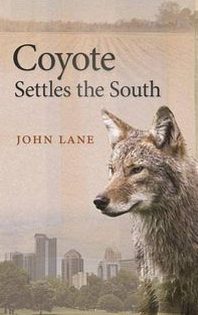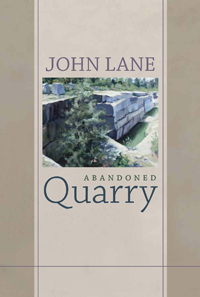A little over a month ago, I attended the closing session of the Pat Conroy festival. Most of the events were held in Beaufort, SC, but the closing one was held in Bluffton, which is just across the river a bit from Savannah. It featured four South Carolina authors talking about place. Afterwards, I picked up a couple more John Lane books, who was one of the authors. I’d previously read two of Lane’s books: My Paddle to the Sea and Waist Deep in Black Water.
John Lane, Coyote Settles the South (Athens, GA: University of Georgia Press, 2016), 186 pages.
The first coyote I saw was thirty-some years ago outside of Virginia City, Nevada. Since then, I have seen them in many other parts of the West, but also in areas far beyond their original range. At one point, coyotes only existed in the American West. As their territory changed, the adapted and began to move eastward. In this book, which is kind of a travel narrative, Lane sets out across the South to learn about how coyotes are adapting to their new territories in the southern part of the country. These animals are taking place of the red wolves, who used to roam eastern woods. They are generally hated, in the same category that rattlesnakes are hated, as they are considered a threat to humans and especially to our pets. While there has been human death to coyotes (there was one during his study of the animal), the animal is very problematic for pets, especially small dogs and cats. They help cull the deer population (they prefer to eat fawns), love fruit, but will also eat armadillos (flip ‘em over and eat ‘em on the half shell). As the coyote is well established and able to reside close to humans, it appears there will be no going back. The beast is a hard one to trap, as one famous coyote from West Virginia showed. This animal was even known to relieve himself right next to traps set out for him as if he was playing with his trappers. After figuring out that it was a male, they finally trapped him using a captive female coyote in heat!
In addition to discussing the coyote, Lane spends time talking about the red wolf, as specie that is in even more danger from the coyote, for the two species have been known to interbred. By the time I got through this book, I find myself having more respect for the coyotes. Lane begins the book describing the first time he heard them at his house in northwest South Carolina. Having been surprised to hear them baying in the woods while out at night skiing in Michigan, I can attest, it’s a beautiful but also hair-raising sound. Pick up this book if you’re interested in nature and in an animal that is a lot cleverer than the cartoon depiction of Wile E. Coyote.
 John Lane Abandon Quarry (Macon, GA: Mercer University Press, 2010), 169 pages.
John Lane Abandon Quarry (Macon, GA: Mercer University Press, 2010), 169 pages.
This is a wonderful collection of poems that capture places and events (real and imagined) in Lane’s life. The author has a keen vision for what’s happening around him, as he travels from Cumberland Island along the Georgia coast to the Virginia mountains and places in between. The bulk of the book are made up of selections from seven previously books of poetry published by Lane. In addition to these seven, there are new poems, some from earlier in his life and others written more recently. Many of the imagined poems were about visits from his father who’d committed suicide when Lane was a child. His father, a veteran of World War II, was a mechanic who ran a gas station. In these “dreams,” he teaches his son about cars and his mother (and women) among other things. I imagine it was helpful for Lane to write these verses. I was shocked to find a poem, “Chicory Brought Inside,” that ties together chicory and Queen Anne’s Lace, two common roadside flowers that often grow together along the ways of the Midwest. It reminded me of a similar poem I wrote years ago. A place I discovered that we’ve both written poems is “Connemara,” the vacation home for Carl Sandburg in the North Carolina mountains. I am still trying to find my poem, which was written in the early 80s. I enjoyed this book of poems immensely and highly recommend them.
Chicory and Lace
by Jeff Garrison, 2009
A smile broke over your face.
You blushed as your eyes twinkled
when you noticed me watching
you raise the cup to your lips
and gently blow across the dark,
before sipping.
It was a chicory blend, wasn’t it?
Served early in the morning
at the sidewalk café
in that town along the Sierra foothills.
We searched for the ghosts of 49ers
yet couldn’t exonerate the spirits of our past.
We lingered that morning, I mesmerized by you,
sitting slightly sideways in a wrought iron chair,
a lacy-white sundress with blue flowers
that stood out against your tanned shoulders and arms,
and those long shapely legs, crossed at the knees,
a flip-flop dangling from your rocking foot
I don’t remember of what we talked,
nor now, even what year it was
for there have been so many since.
But I remember the chicory coffee and the lace of your dress
and seeing chicory grow wild along the roadside,
amongst the Queen Anne Lace, I smile.

Lovely poem. I enjoyed it.
That’s interesting about coyotes moving out of the west. I see them pretty much every day at work, and there are some in the gulch behind my house. There are so many coyotes around here that the government has made cyanide bombs legal again to kill them. Honestly, cyanide bombs scare me more than coyotes. I do not want to come across one of those.
Thank you for your kind comments about my poem.
quite surprising that cayote found in the south.
# For me that your Poem describes “the nature” with love…fantastic
Coyotes have come back to New England as well. We hear them sometimes. They are one of so many reasons we don’t let our cats outside. Unfortunately, they aren’t making much of a dent in the deer population – big over-population issues there.
I like the trapping story!
There is something about that coyote taking a dump next to the trap that was set for him! Clever bugger, but then they are able to live close to humans without getting caught.
Well I’m insanely jealous of your attending any part of the Pat Conroy festival, but I’ll try to get over it.
As for coyotes, they roam our neighborhood at times and I was especially aware of them when we had our little terrier mix dog. As for people, they pretty much leave us alone unless we have a dog or cat with us.
Beautiful poem and two more good book recommendations.
The festival is held in late October/early November. It would be nice to be able to take part in more of it, but to do that I’d need to take those days off work! Thanks for your kind comments about my poem and reviews.
Fantastic poem!!
I don’t know this books but it seems really interesting 🙂
Thank you!
People here in Vegas have been posting pictures of coyotes they’ve spotted near their homes. It’s happening more and more these days. Vegas has been building further and further out and the wildlife is starting to make themselves at home near the newer homes.
Coyotes are interesting animals and have existed in LA for years.
The books sound interesting …
I did enjoy your poem, thanks for sharing it here.
All the best Jan
Thanks Jan.
Love your poem! I have never seen any coyote, they don’t live in Poland, but they are beautiful creatures, I think!
They can be beautiful and they can be rangy, too. I saw one in Yellowstone once who came up to me. I was a little afraid, as its not natural for animals to do that unless something is wrong (like rabies) but this coyote hadn’t passed its animal identification test and had gotten into a battle with a porcupine. I felt sorry for the animal for its snout was filled with porcupine quills. I hope the rangers were able to capture it, otherwise, it would starve.
I’m not a fan of coyotes. Having livestock (particularly when we raised goats), we only see them as a nuisance. Hearing them at night always gives me the shivers and causes our dogs to stay close to the house.
Lovely poem, Jeff.
I can understand how coyotes are not liked by those with livestock. but interestingly, they adapt too well and once established in an area, are hard to eliminate.
Beautiful poem, very descriptive. I could feel, see and taste that cup of coffee. The book about coyotes sound fascinating.
sounds
There’s nothing like good coffee!
Beautiful poem, you are very talented! About first book, it looks like coyotes are smart and clever animals 🙂
They may be depicted as dump in the cartoons, but they are quite smart. Have you ever seen the Roadrunner cartoons, where the coyote is chasing the bird?
I enjoyed your poem, specially the ending. The books sound interesting too
with your interest in the natural world, I think you’d like the book.
Hi, Jeff! I thoroughly enjoyed your post. First, your poem was lovely. Queen Anne’s Lace grows all over the place in Nova Scotia, but I don’t think chicory does. I will remember your poem when I see QAL in NS.
As for coyotes, we have them in our area. I hear them more than I see them, and sadly development is driving them out. I was shocked to learn about 30 years ago (mid-1980s) coyotes made it to Newfoundland. They had to make it across the sea ice in the winter from Nova Scotia. Actually, I was shocked when they made it to Nova Scotia in 1977. Unfortunately NS has the dubious record of having the only known case in Canada of a person killed by coyotes.
My youngest niece on my side of our family is finishing up her first term at the Atlantic Veterinary College at the University of Prince Edward Island. During her last year at Acadia University in Nova Scotia she had a part time job for the Department of Lands and Forest (Wildlife Division) performing autopsies on all the coyotes killed in Nova Scotia. I always tease her that that’s what got her into vet school.
I’ll have to look for the book you shared. All the best to you!
Louise, I wrote this poem when I lived in Michigan. In that part of the country, the fields and highways are covered with Queen Anne’s Lace, but you don’t see it here. The flower was a sign that summer was waning as they tended to peak in August. I had no idea coyotes had made it to Newfoundland!